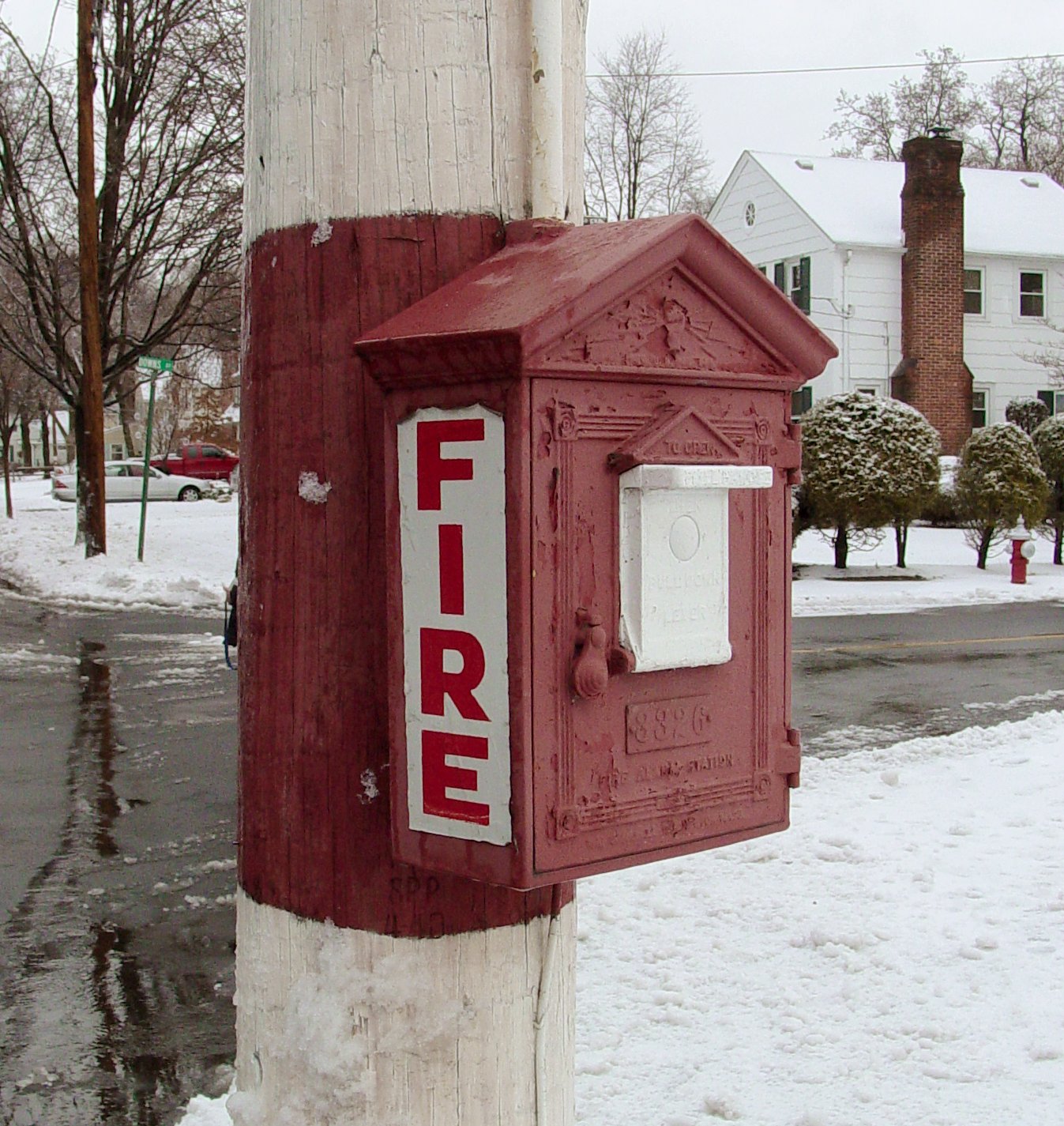|

Fire Alarm Boxes
They stand like sentinels on city sidewalks. Mounted on each black pedestal is a red box shaped like a miniature house, with a white pull-handle on the front, its purpose spelled out plainly in capital letters.
"FOR FIRE," it reads, then continues simply: "OPEN THEN PULL DOWN HOOK."
Whenever that lever is pulled, a metal wheel inside the box turns and transmits a signal via telegraph to the Fire Department.
That's the way it was over 150 years ago, when the world's first fire-alarm telegraph boxes were invented here and horse-drawn carriages rattled down the city's cobblestone streets.
And that's the way it is today, in this age of enhanced 911, two-way radios, cellphones, and GPS devices, leaving some to wonder why the city still operates a telegraph alarm system.
Fire officials say the wireless world hasn't negated the system's value. They point to the Sept. 11 attacks, when cellphone networks became overloaded. And in a blackout, they say, people can't recharge their cellphones.
Born before the phone
The world's first municipal fire-alarm system was developed by an engineer named Moses Farmer and Dr. William Channing, a Harvard-educated Bostonian who preferred tinkering with electronics to practicing medicine. Their revolutionary creation was installed in Boston in 1851, more than two decades before Alexander Graham Bell gained his patent for the telephone, and consisted of 40 miles of wire and 45 boxes. It quickly became a national model, and cities and towns across the country installed similar systems that were manufactured by the Gamewell Fire Alarm Telegraph Co. in Newton Upper Falls. By 1890, there were Gamewell systems in 500 cities and towns across the country.
In case of any emergency
The system operates separately from electric and telephone lines, and isn't affected by power outages, downed phone lines, bad cellphone reception, or radio interference. If a major disaster knocked out power for days, and people couldn't charge their cellphones, the boxes would be a public safety lifeline.
When a computer glitch caused New York City's 911 system to crash for two hours in March 2004, the street boxes continued to work, and someone used one to report a serious fire in Brooklyn. When he was mayor of New York, Rudolph W. Giuliani tried to get rid of the city's fire boxes, but failed. A court ruled that eliminating them would violate the rights of deaf people.
They're also helpful for people who have speech problems or are simply unfamiliar with the city, because the box transmits their exact location.
If someone is new to the city, and don't know where they are, or if they're new to this country, and don't speak English, help is on the way, no matter what.
The sheer speed and precision of the old-fashioned pull-box system is still unmatched. If you called 911 on your cellphone, you have to wait for the call to be routed to a dispatcher, who will then ask you a series of questions. The pull-box sends the signal instantly, no questions asked.
The importance is that, in this day and age, fire-alarm boxes are still a fantastic, dependable system for notifying the Fire Department of emergencies. Technology has advanced, but they still have a place.
How the Boxes Work
Miles of copper wiring throughout the city connect each alarm box to an electronic grid. Inside each box is a clock-like mechanism.
First, the force exerted by pulling down on the lever causes a gear inside the box to spin. Each box is identified by a specific number, and the spinning gear has a series of notches on its outer edge that correlates with that number. For example, the outer edge of the gear inside box 1818 has one notch, then a space, then eight notches, then a space, then one notch, a space, and eight notches.
Spinning gears complete electric circuits, which transmit information via copper wires to the Fire Alarm Office. On the fire department’s end, the message 1-8-1-8 appears on a computer to show an alarm was sounded, and where.
Newer computers makes the location process relatively quick but as a back up incoming telegraph messages work by punching holes in a piece of paper.
So if someone pulls alarm box number 57, the message will be sent to the dispatch office with five holes in a piece of paper, a space, and then seven more holes. Fire department dispatchers then turn that hole-filled paper into coordinates to send a team.
It’s obviously old technology, but it’s fairly simple and it Works.
Essentially, you pull the lever and the fire department knows it.
|